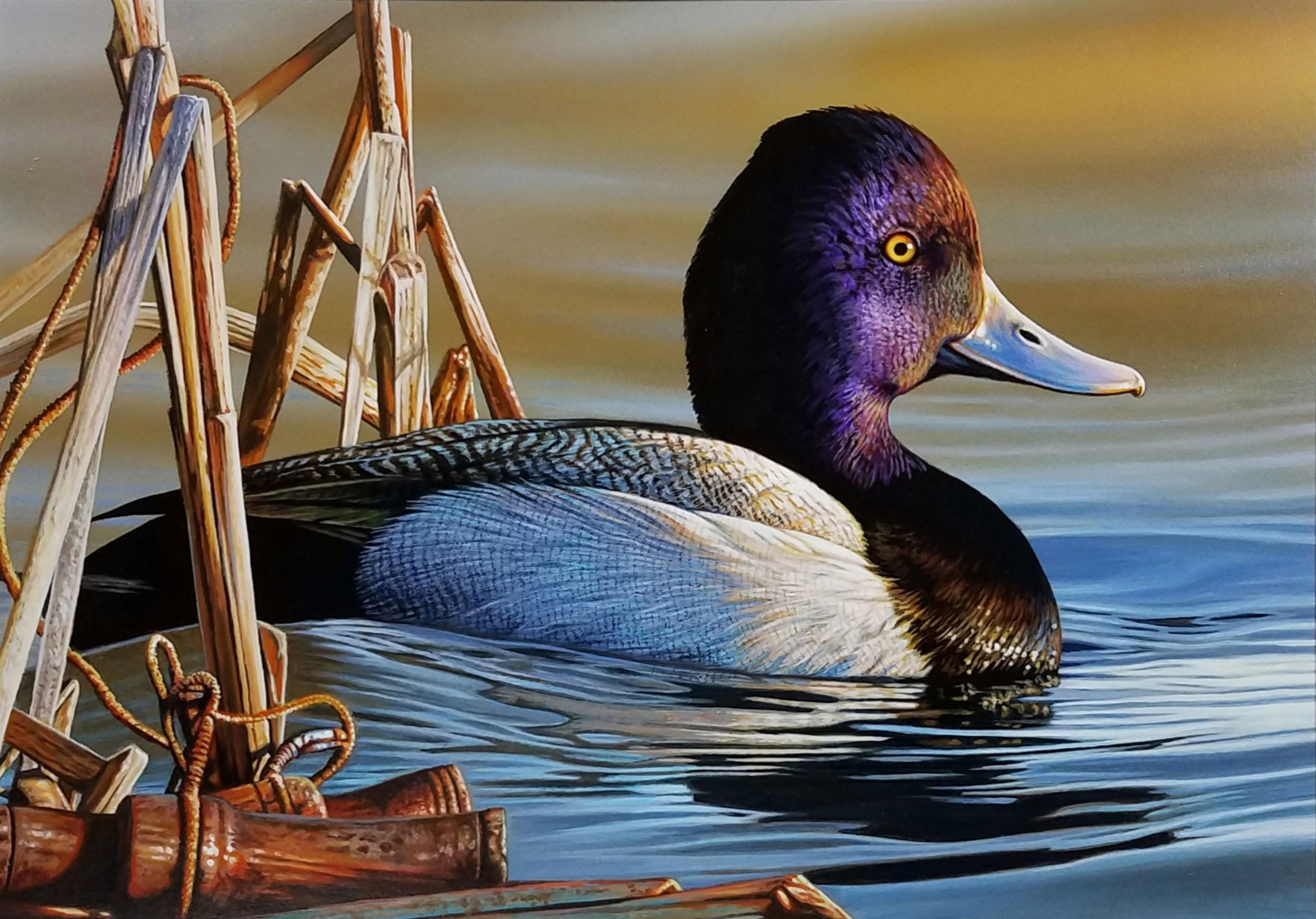
As the US elections approach next month, even the annual contest to design next year’s Federal Migratory Bird Hunting and Conservation Stamp, better known as the Duck Stamp, is mired in controversy.
In a controversial new rule, each design is now required to incorporate the theme of “celebrating our waterfowl hunting heritage,” and that isn’t sitting well with some animal rights groups. The organization Friends of Animals filed a lawsuit in Connecticut district court late last month against the US Fish and Wildlife Services, decrying the rule as “anti-wildlife” and “anti-conservation,” reports the CT Post.
“It’s almost comical the desperate lengths the dwindling hunting industry is willing to go to make its clients feel relevant,” said the group’s president, Priscilla Feral, in a statement. “But jeopardizing crucial wetland habitat protection is not a laughing matter, so we had to take legal action.”
Greg Alexander’s entry to the 2020 Duck Stamp contest, depicting a Cinnamon Teal and a spent shotgun shell. ©U.S. Fish and Wildlife Service.
This year’s 138 entries included duck decoys, retrieving dogs, duck blinds, and hunters lying in wait. But many went for the easiest option: Spent shotgun shells or lost duck calls floating amid an otherwise bucolic scene.
“That looks to me like litter,” Missouri wildlife artist Rebekah Knight, who painted a decoy in the background of her submission to the contest, told Audobon Magazine. “It’s just not good for trying to get the correct message across for people who don’t know anything about hunting.”
The first Duck Stamp was issued in 1934, after President Franklin Delano Roosevelt passed the Migratory Bird Hunting Stamp Act. Under its regulations, all waterfowl hunters 16 and older are required to purchase a Duck Stamp to affix to their hunting license each year, with 98 percent of the proceeds of stamp sales going toward the federal purchase and management of wetlands.
The act was a huge success, saving species like the over-hunted Wood Duck and other wild game birds from the verge of extinction, and combating habitat loss. The price of the duck stamp has risen from $1 to $25 since its introduction, with sales to date raising more than $1.1 billion to support the preservation of over six million acres of waterfowl habitat.
Jay N. “Ding” Darling designed the first Duck Stamp in 1935. Photo Richard Clifton’s winning entry to the 2020 Duck Stamp contest, depicting a Lesser Scaup and a lost duck call. ©U.S. Fish and Wildlife Service.
The stamps, which cannot be used as postage, grant free entry to any of the more than 300 national wildlife refuges, and are also purchased by those looking to support habitat conservation.
Highlighting hunting in the Duck Stamp is part of an executive order aiming to “support and expand hunting and fishing, enhance conservation stewardship, improve wildlife management and increase outdoor recreation opportunities for all Americans.”
But with the number of hunters shrinking to just four percent of Americans over 16, according to a 2016 Fish and Wildlife Services survey, there are concerns that the new focus on hunting will alienate other audiences and hurt the cause.
Walter A. Weber was the first artist to win the national competition to designed the Duck Stamp, in 1949. ©U.S. Fish and Wildlife Service.
After the rule change was proposed in February, the public was invited to submit feedback. “The limits placed on the creativity of artists by this rule will contribute to the already steady decline in the number of contest entries,” argued one response, as reported by Linn’s Stamp News.
“Requiring a hunting theme will discourage non-hunters from purchasing the stamps,” read another. “As a hunter and life-long bird lover, I know that many people are uncomfortable with the idea of killing birds, and would not appreciate stamps that depict this activity.”
The Duck Stamp was the brainchild of Pulitzer Prize-winning cartoonist Jay N. “Ding” Darling. The plight of wild ducks was an important issue for the artist, as illustrated in his 1930 political cartoon predicting that excessive hunting would drive them to extinction. Etchings of Darling’s first Duck Stamp, featuring a brush and ink drawing of mallard ducks, have sold for over $5,000 at auction, according to the Artnet Price Database.
Maynard Reece designed the 1959 Duck Stamp, perhaps the best-known in the series, featuring retriever King Buck. The artist, who shares the record for the most Duck Stamp wins with five, died in July 2020 at age 100. ©U.S. Fish and Wildlife Service.
Beginning in 1949, each stamp was chosen through a national art contest, a prestigious affair that is the federal government’s only juried art competition. The rules call for the artist to depict a live bird in its natural habitat, with the option to chose from five featured species each year.
The winning Duck Stamp design for the 2021 to 2022 season is by Richard Clifton, who previously won in 2007.
“Hunters and anglers are the backbone of American conservation, and the Duck Stamp is one of the many ways they contribute to conserving America’s waterfowl and wetlands throughout the country,” said secretary of the interior David Bernhardt in a statement. “I encourage everyone, including those who do not hunt, to buy a Duck Stamp as it makes a real impact in conserving wildlife species and wetlands habitat.”